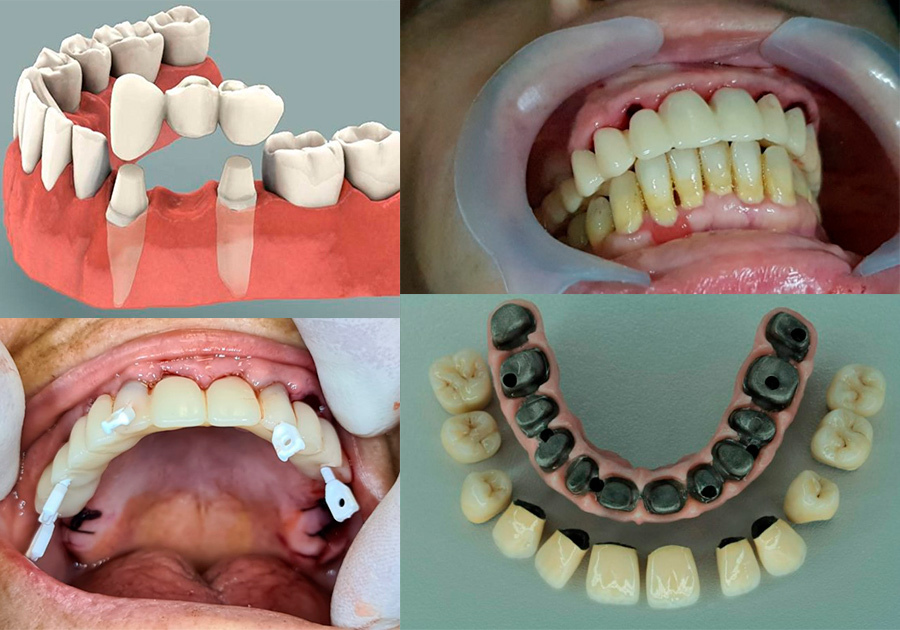Protesi dentali

By Trohimenko YS - Own work, CC BY-SA 4.0, Link

By Coronation Dental Specialty Group - Own work, CC BY-SA 3.0, Link
Le protesi dentali sono dispositivi utilizzati per sostituire uno o più denti mancanti, ripristinando sia la funzione masticatoria sia l’estetica del sorriso. Si dividono principalmente in due categorie:
1. Protesi dentarie fisse
Sono applicazioni stabili e permanenti che non il paziente non può rimuovere autonomamente. Possono essere:
Corone o capsule dentali: rivestono singoli denti compromessi o impianti; realizzate in materiali come metallo-ceramica, zirconio, disilicato di litio o metallo-composito, con alta resistenza ed estetica naturale.
Ponte dentale: struttura che sostituisce uno o più denti mancanti, ancorata a denti naturali o impianti.
Protesi totali fisse (es. Protesi Toronto): sostituzione dell’intera arcata, solitamente avvitata su più impianti dentali.
Protesi circolare: ponte lungo che incapsula tutti i denti residui di un’arcata.
Maryland bridge: ponte “adesivo” con struttura metallica e denti supportati in modo adesivo.
Vantaggi:
Stabilità e comfort elevati
Aspetto estetico molto naturale
Funzionalità simile a denti naturali
Svantaggi:
Necessità di limare denti naturali vicini (per ponti)
Costi più elevati rispetto a protesi mobili
Non rimovibili dal paziente
2. Protesi dentarie mobili
Sono protesi che il paziente può rimuovere autonomamente per la pulizia; indicata quando mancano molti o tutti i denti.
Protesi parziali mobili: sostituiscono alcuni denti e si ancorano a denti naturali tramite ganci o attacchi di precisione; possono avere struttura in resina e metallo.
Protesi totali mobili (dentiera): sostituiscono tutti i denti di un’arcata e vengono stabilizzate sulle gengive con adesione naturale o adesivi specifici.
Vantaggi:
Prezzo più contenuto
Facili da rimuovere per pulizia e manutenzione
Non richiedono interventi invasivi sui denti residui
Svantaggi:
Meno stabile rispetto alle protesi fisse
Possibili fastidi o difficoltà masticatorie
Necessità di manutenzione regolare e periodica regolazione
Altre classificazioni e soluzioni
Protesi combinate: utilizzano sia elementi fissi sia rimovibili, ad esempio protesi che si agganciano a impianti o a denti naturali tramite attacchi.
Protesi implantari fisse: protesi realizzate su impianti dentali, con maggiore stabilità e durata.
Sintesi in tabella
Tipo di protesi |
Caratteristiche principali |
Vantaggi |
Svantaggi |
|---|---|---|---|
Protesi fissa |
Non rimovibile, su denti naturali o impianti |
Stabilità, estetica naturale, funzionalità |
Costo elevato, intervento invasivo |
Protesi mobile parziale |
Rimovibile, sostituisce alcuni denti |
Prezzo contenuto, facile da pulire |
Meno stabile, può causare fastidi |
Protesi mobile totale (dentiera) |
Rimovibile, sostituisce intera arcata |
Prezzo contenuto, adatta a edentulie totali |
Stabilità ridotta, necessità di adesivi |
Per una scelta ottimale è importante una valutazione clinica personalizzata con l’odontoiatra, che consideri condizioni orali, esigenze estetiche, funzionali e budget del paziente.
English version
Dental Prosthetics
Dental prosthetics are devices used to replace one or more missing teeth, restoring both chewing function and the aesthetics of the smile. They are mainly divided into two categories:
1. Fixed Dental Prosthetics
They are stable and permanent appliances that cannot be removed by the patient. They can be:
Dental crowns or caps: These cover individual missing teeth or implants; they are made of materials such as metal-ceramic, zirconium, lithium disilicate, or metal-composite, with high strength and natural aesthetics.
Dental bridge: A structure that replaces one or more missing teeth, anchored to natural teeth or implants.
Fixed Complete Dentures (e.g., Toronto Dentures): Replacement of the entire arch, usually screwed onto multiple dental implants.
Circular Denture: A long bridge that encapsulates all the remaining teeth in an arch.
Maryland Bridge: An "adhesive" bridge with a metal framework and adhesively supported teeth.
Advantages:
High stability and comfort
Very natural aesthetic appearance
Functionality similar to natural teeth
Disadvantages:
Requires filing down adjacent natural teeth (for bridges)
Higher costs than removable dentures
Not removable by the patient
2. Removable Dentures
These are dentures that the patient can remove independently for cleaning; they are indicated when many or all teeth are missing.
Removable Partial Dentures: These replace several teeth and are anchored to natural teeth with clasps or precision attachments; they can have a resin or metal structure.
Removable Complete Dentures (dentures): These replace all the teeth in an arch and are stabilized on the gums with natural adhesion or specific adhesives.
Advantages:
Lower price
Easy to remove for cleaning and maintenance
No invasive procedures on the remaining teeth are required
Disadvantages:
Less stable than fixed dentures
Possible discomfort or chewing difficulties
Requires regular maintenance and periodic adjustments
Other classifications and solutions
Combined dentures: These use both fixed and removable elements, for example, dentures that attach to implants or natural teeth via attachments.
Fixed implant dentures: These dentures are made on dental implants, offering greater stability and durability.
Fonti (sources):
https://niodent.ch/blogs/protesi-dentarie-quanti-tipi-di-protesi-dentali-esistono/
https://www.hdental.it/odontoiatria/protesi-dentaria/protesi-fissa/
https://studiodentisticosantevassallo.it/le-tipologie-protesi-dentali-fisse/
https://www.geldis.it/blog-igiene-orale/igiene-dentale-news/le-tipologie-di-protesi-dentaria/
https://studiopirasdenotti.it/blog/protesi-dentali-tipologie-differenze/
https://www.futudent-clinica.it/la-protesi-dentale-tipologie-igiene-e-curiosita/
Puoi seguire anche il mio canale YouTube https://www.youtube.com/channel/UCoOgys_fRjBrHmx2psNALow/ con tanti video interessanti
I consigli che offriamo sono di natura generale. Non sono consigli legali o professionali. Quello che può funzionare per una persona potrebbe non essere adatto a un’altra, e dipende da molte variabili.
Per supportare e far crescere il canale in modo semplice, rapido e gratuito, potete fare acquisti su amazon usando il mio link di affiliazione.
Questo implica che io prenda una commissione ogni volta che qualcuno faccia un qualsiasi acquisto utilizzando il mio link di affiliazione https://amzn.to/4cgJ3Ls
Commenti
Posta un commento